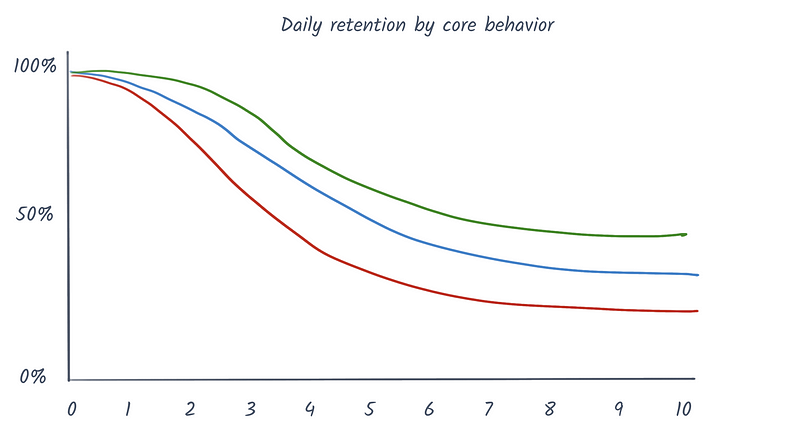💫 Choosing a Retention Metric
Oct 24, 2020 • 4 min • Growth
It's not super controversial that retention is a big deal for startups. What is a little more controversial, or maybe just less well-known, is how to go about improving retention in your product.
This post is the first in a short series on just that: Measuring, understanding, and improving retention. The inclusion of both "measuring" and "understanding" in the prior statement is meaningful. Paraphrasing the great Peter Drucker, if you want to improve something, you have to measure it. And in order to do that for retention, you need to decide on a metric.
Reforge does a good job of breaking down retention metrics into two component: Frequency and core behavior. Basically, what does someone do and how often do they need to do it in order to be considered retained?
Frequency
In order to determine the right frequency for your metric, you first need to understand the natural cadence of the problem that you're solving. If you're Facebook, you expect users to check social media daily. But if you're Airbnb, you don't expect people to book a trip daily. Different problems have different frequencies:
A second part of accurately measuring retention lies in choosing the right frequency for product engagement. When considering the right frequency for your product’s retention metric, ask yourself, “Does a user of my product need to engage on a daily, weekly, or monthly basis to be considered active (or possibly longer for certain products)?” Measuring retention on the wrong cadence can trick you into thinking your product has good retention when it really doesn’t.
Chances are that the frequency for your product is somewhat intuitive, but there's also a systematic way to determine this with data if you want to check your work:
- Filter users by some minimum engagement threshold
- Look at the last 30 days of product event data
- Compute how many days each user returned in that period
- Visualize results in a histogram and observe clusters
If you see the most substantial cluster of people returning <3 days, lean toward a monthly frequency. Similarly, if most return 3-10 days then weekly, and 10+ days indicate daily would be best. I would defer to your intuition and understanding of the problem you're solving, but this exercise can be helpful as validation.

Core Behavior
Once you have frequency figured out, the next piece of the puzzle is the behavior that you are optimizing for. In my experience, this is the trickier one.
The heuristic I recommend here is: What behavior in the product signals realization of value? Ideally, you have pinpointed this magic moment where users seem to get your value proposition. If not, then no worries. These things can be figured out. As always, examples are helpful:
- Uber: Booking a trip
- Facebook: Viewing the news feed
- Slack: Messaging someone
- Notion: Creating a note
- Airtable: Logging a record
As we love data here, there's also a more systematic way to decide on your core behavior. Once you have brainstormed a handful of actions that might be value realization moments, you can map them to your frequency and visualize retention curves (more on this in a future post) for each of them. Ideally, you should choose an action with stronger retention, as it's more aligned with success.

Putting it Together
Once you have these two components, you're off and running! Of course, there are more details to brush out, but these initial steps will get you a long way to effectively measuring retention.
For instance, should you require doing the action X times? How do you define your frequency? Does weekly mean 3 of 4 weeks or 4 consecutive weeks?
These are questions you need to have answered, ideally in a way that is accurate, but also easy to message across the organization. If you want your team to rally around this common goal of improving retention, they first need to understand where the goal posts are and how the metric works. As always, here are the resources that I found helpful in creating this post:
- How to Find Your Aha Moment?
- Why Retention is the Silent Killer
- Pinterest's Retention Win
- The Power User Curve
If you enjoyed this post and you’re feeling generous, perhaps like or retweet the post on Twitter. You can also subscribe in the form below to get future posts like this one straight to your inbox. 🔥